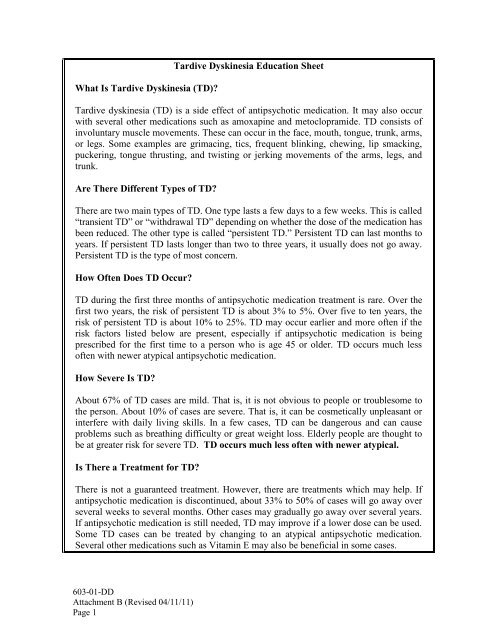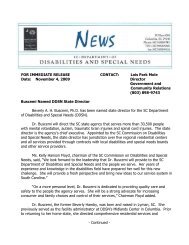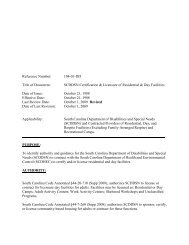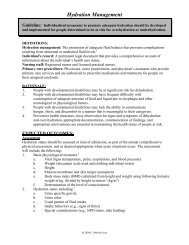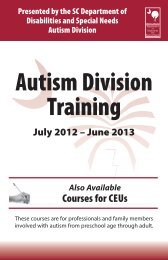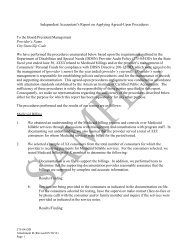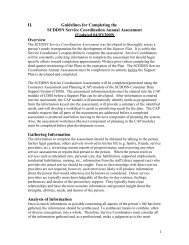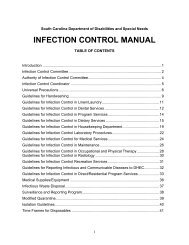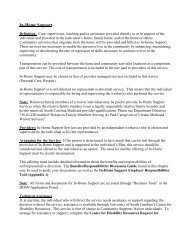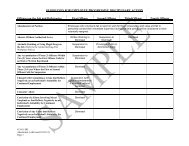Tardive Dyskinesia Education Sheet
Tardive Dyskinesia Education Sheet
Tardive Dyskinesia Education Sheet
You also want an ePaper? Increase the reach of your titles
YUMPU automatically turns print PDFs into web optimized ePapers that Google loves.
What Is <strong>Tardive</strong> <strong>Dyskinesia</strong> (TD)?<strong>Tardive</strong> <strong>Dyskinesia</strong> <strong>Education</strong> <strong>Sheet</strong><strong>Tardive</strong> dyskinesia (TD) is a side effect of antipsychotic medication. It may also occurwith several other medications such as amoxapine and metoclopramide. TD consists ofinvoluntary muscle movements. These can occur in the face, mouth, tongue, trunk, arms,or legs. Some examples are grimacing, tics, frequent blinking, chewing, lip smacking,puckering, tongue thrusting, and twisting or jerking movements of the arms, legs, andtrunk.Are There Different Types of TD?There are two main types of TD. One type lasts a few days to a few weeks. This is called“transient TD” or “withdrawal TD” depending on whether the dose of the medication hasbeen reduced. The other type is called “persistent TD.” Persistent TD can last months toyears. If persistent TD lasts longer than two to three years, it usually does not go away.Persistent TD is the type of most concern.How Often Does TD Occur?TD during the first three months of antipsychotic medication treatment is rare. Over thefirst two years, the risk of persistent TD is about 3% to 5%. Over five to ten years, therisk of persistent TD is about 10% to 25%. TD may occur earlier and more often if therisk factors listed below are present, especially if antipsychotic medication is beingprescribed for the first time to a person who is age 45 or older. TD occurs much lessoften with newer atypical antipsychotic medication.How Severe Is TD?About 67% of TD cases are mild. That is, it is not obvious to people or troublesome tothe person. About 10% of cases are severe. That is, it can be cosmetically unpleasant orinterfere with daily living skills. In a few cases, TD can be dangerous and can causeproblems such as breathing difficulty or great weight loss. Elderly people are thought tobe at greater risk for severe TD. TD occurs much less often with newer atypical.Is There a Treatment for TD?There is not a guaranteed treatment. However, there are treatments which may help. Ifantipsychotic medication is discontinued, about 33% to 50% of cases will go away overseveral weeks to several months. Other cases may gradually go away over several years.If antipsychotic medication is still needed, TD may improve if a lower dose can be used.Some TD cases can be treated by changing to an atypical antipsychotic medication.Several other medications such as Vitamin E may also be beneficial in some cases.603-01-DDAttachment B (Revised 04/11/11)Page 1
<strong>Tardive</strong> <strong>Dyskinesia</strong> <strong>Education</strong> <strong>Sheet</strong>Do Some People Get TD More Than Others?It is not clear why one person develops TD and another does not. While some studiessuggest that there may be other risk factors such as diabetes, the following items arethought to be the major risk factors. Please remember these do not predict whether aspecific person will actually develop TD.Age, especially age 45 or aboveAn affective or mood conditionOther types of movement side effects early in treatmentGreater time or a greater amount of antipsychotic medication prescribed over theyearsHead injury or organic brain damageAre There Other Late Developing Movement Like TD?Yes. <strong>Tardive</strong> blepharospasm involves the eyelid muscles half-closing so the field ofvision is affected. <strong>Tardive</strong> dystonia involves muscle stiffness which twists or jerks thehead, trunk, or limbs. Both of these conditions are rare, but both are usually severe anddifficult to treat. <strong>Tardive</strong> akathisia involves an inability to sit still or a feeling ofrestlessness. This occurs more frequently.What Should I Do?There are three things to do.First, carefully consider the benefits of this medication. Think if it has helped or canhelp you. These medications have helped hundreds of thousands of people live betterlives. While TD is a problem, please consider any problems which might occur ifantipsychotic medication is not taken. While TD can occur, many people do notdevelop TD.Second, tell the doctor or nurse if you see any unusual movements. They have beentrained to do an examination to check for these movements. Although regularexaminations occur, any help from you is important.Third, be alert to any muscle changes if the dose is lowered or the medicationstopped. Many times TD is not seen until the dose is very low or the medicationstopped. Tell the doctor or nurse of any changes.The information on this sheet does not cover all possible aspects of TD. It is asummary of the professional literature as of July 2007.603-01-DDAttachment B (Revised 04/11/11)Page 2


